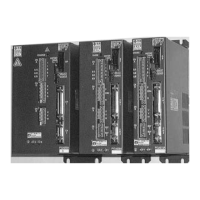4. WIRING
4-6
Note 1) : For the parts marked , use a twisted pair shielded cable.
Note 2) : Select the power supply from the two types, 5 V or 12 V to 24 V.
CN1 -
38 pin
CN1 -
49 pin
5 V used Connected Open
12 to 24 V used Open Connected
Note 3) : RDY (RDY1 or 2 terminal) output is optional.
RDY (RDY1 or 2 terminal) is a contact output.
Contact rating: 250 VAC, 2 A
30 VDC, 2 A
Inductive load: COSφ = 0.4, L/R = 7 mS
Note 4) :
Amp. capacity
CND terminal
*1
Built-in type
regenerative resistor
Use of built-in type
regenerative resistor
*2
Method of connecting external
regenerative resistor
*3
15, 30 A
(Normal)
P, Y (or COM), N None Connect it between
the P and Y (or COM) terminals.
30 A
(Special)
P, Y, N Equipped Same as default connection.
Connect it between
the P and Y terminals.
Connect it between
the P and Y terminals after removing
the wiring connected between
the P and Y terminals.
*4
50 A
(Normal)
P, Y, X, N Equipped Same as the default.
Short-circuit the P and X
terminals using a short-circuit
bar.
Connect it between the P and X
terminals after removing the
short-circuit bar across
P and X terminals.
*1 : The N terminal is for maintenance (high-voltage circuit). So, do not wire the N terminal.
*2 : The thermostat contact output of the built-in regenerative resistor is connected inside the amplifier.
*3 : A thermostat for the external regenerative resistor shall be built into the user device, or connected to the external overheat detection
input to protect the resistor.
*4 : Be careful not to bring the removed wire into contact with the conductive parts.
Note 5) : Refer to 4.6.2 CN1 & CN2 Shielding Procedure.
Note 6) : Motor connection differs to the motor specifications. The indications of red, white, black, green and orange apply when the motor
power and brake lines are the lead type. When they are the cannon plug type, connect them according to the motor specifications.
Note 7) : For how to wire the sensor connector, refer to the sensor wiring diagram.
Note 8) : The functions of command input differ depending on control modes.
Command input terminal
Control mode
Position command
pulse input
Velocity command input
Torque command input
Position control type Position command
pulse input
Velocity addition input is assumed
depending on the setting of Func1.
Torque compensation input is
assumed depending on the setting of
Func1.
Velocity control type − Velocity command input Torque compensation input is
assumed depending on the setting of
Func1.
Torque control type − − Torque command input
Velocity/torque
switch type
No switching − Velocity command input Torque compensation input is
assumed depending on the setting of
Func1.
During
switching
− − Torque command input
Position/torque
switch type
No switching Position command
pulse input
Velocity addition input is assumed
depending on the setting of Func1.
Torque compensation input is
assumed depending on the setting of
Func1.
During
switching
− − Torque command input
Position/velocity
switch type
No switching Position command
pulse input
Velocity addition input is assumed
depending on the setting of Func1.
Torque compensation input is
assumed depending on the setting of
Func1.
During
switching
− Velocity command input Torque compensation input is
assumed depending on the setting of
Func1.
5 V input
38
12 V to 24 V
input
Max.
30 VDC
O I
49
G
5 V input:
10 mA max.
12 to 24 V input:
50 mA max.
Output common

